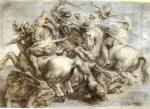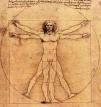|
Lessons >>> Lesson 32 |
 Leonardo da Vinci was an immensely talented painter, engineer, sculptor, architect, musician, mathematician, scientist and inventor lived during the Italian Renaissance. What is unique about Leonardo and make him an universal genius, is that he excelled at both technical and creative endeavors in a wide variety of fields. He completely embodies the notion of the inquisitive "Renaissance Man". Leonardo da Vinci was born on April 15, 1452. The actual location of Leonardo's birth is uncertain - some say Vinci (about 50km west of Florence), others believe Anchiano (near Vinci). Nevertheless, Vinci claims the prestigious title of his birthplace ("da Vinci" means "from the town of Vinci"). Leonardo was the illegitimate son of Ser Piero da Vinci, a wealthy 25-year-old notary of Florence, and local peasant girl, who is only known by her first name, Caterina. Leonardo was born out of wedlock but his father took custody of the little fellow shortly after his birth. Leonardo never attended public school but growing up in his father's home he had access to scholarly texts owned by family and friends. Early sources describe his superlative male beauty, charm of manner, and precocious display of artistic talent. He was an excellent singer and musician, and even as a young boy, demonstrated a great talent for drawing. When Leonardo was 15, his father apprenticed him to Andrea del Verrocchio, the leading artist of Florence and the early Renaissance. He served at least ten years (1466-1476) as Garzone (apprentice) to Andrea del Verrocchio and painted details in Verrocchio's canvases. In 1475 da Vinci painted the kneeling angel on the left and the landscape of the Verrocchio's picture Baptism of Christ. Leonardo's lack of formal education and his methods of self-education led him down paths which were not common. His apprenticeship as a painter trained him to be unusually observant to the world. He learned through his observations and experiments. It was during this apprenticeship that he became acquainted with most of the things that were to shape his future life, painting, sculpture, mathematics, astronomy and philosophy, although to the end of his life mechanics was his greatest love. With his paintings, he introduced new techniques, and researched concepts such as drawing in perspective. In 1472, he was accepted into the painter's guild of Florence and officially graduated from apprentice to master. After leaving Verrocchio's studio in 1478, Leonardo remained in Florence where he worked independently. His early paintings include Ginevra de Benu (1474), Adoration of the Magi (1481), Benois Madonna (1481), Saint Jerome (1481), and an altarpiece for the chapel of the Palazzo Vecchio. The unfinished Adoration of the Magi is the most important of all the early paintings. About 1482 Leonardo became the court artist for the duke of Milan, Ludovico Sforza and spent 17 years working for him. Da Vinci wrote the duke an astonishing letter in which he claimed that he could build portable bridges, ships, armored vehicles, and other war machines, and that he could execute sculpture in marble, bronze, and clay. In Milan he served at the same time as a military engineer, architect and artist. During his long stay in Milan, da Vinci painted The Virgin of the Rocks and The Last Supper. He also produced many other paintings and drawings (most of which have been lost), theater designs, architectural drawings, domed churches, fortresses and canals. His largest commission was for a colossal bronze monument of Sforza's father on horseback, that Leonardo never finished. Leonardo Da Vinci returned to Florence once more in 1503, at which time he was commissioned to paint a mural in the council hall in Florence's Palazzo Vecchio. Leonardo's work, entitled The Battle of Anghiari, which was never completed, would have measured 23 x 56 feet, double the size of his masterpiece The Last Supper. While working on The Battle of Anghiari, the French governor of Milan hired Leonardo, and once again Da Vinci abandoned his project to begin employment elsewhere. In his lifetime, Leonardo began dozens of paintings, but abandoned the majority of them before they were completed, never returning to finish them. Many artists attest that this is not an occurrence unique to da Vinci, and that such abandonment stems from creative exhaustion. But psychologists and historians speculate that da Vinci's personality was simply too restless to complete many projects, most of which were started simultaneously and abandoned on a whim. One of Leonardo's great accomplishment, which still so fascinate the world, is the famous Mona Lisa (originally called La Gioconda). Even more captivating to the imagination of many is the controversial self-portrait da Vinci sketched in his later years. Its structural similarity to the face of the Mona Lisa has long held the interest of artists and scientists. To this day no one knows whether the woman in the painting was a real person, or whether it was Leonardo's vision of himself as a women. Leonardo seems to have had a special affection for the picture, for he took it with him on all of his subsequent travels. Leonardo da Vinci's personal life is shrouded in secrecy and the question of his sexuality still remains a mystery. There is no record of any woman in his life or even a close friendship with one. In contrast, throughout his life, Leonardo surrounded himself with beautiful young men, and his drawings and writings evince a deep appreciation for male beauty. Besides being a skillful artist, Leonardo was also known as a remarkable inventor, and a brilliant scientist. Leonardo designed a myriad of inventions, although few of these designs were constructed in his lifetime. In his later years, he devoted a substantial amount of time to carefully constructed notebooks filled with scientific notations and compelling sketches, all meticulously inscribed backwards (starting at the right side of the page and moving to the left), so that they can only be read with the aid of a mirror. Leonardo was left-handed, so mirror writing came easily and naturally to him. Some say that although unusual, this mirror writing is a trait shared by many left-handed dyslexic people. The breadth of his inventive prowess is astounding in light of his many other pursuits. Da Vinci designed or created devices that could immediately be employed in his own day, such as water pumps. He also drew up devices that are commonplace today, but would have been flights of fancy in his time, such as his design for a submarine. Based on the gear, he came up with loads of different ideas, including the bicycle and an "auto-mobile". He sketched designs of many different flying machines. Leonardo designed an flying machine that bears a striking resemblance to modern helicopters. Although Leonardo despised war he worked as a military engineer to invent many military weapons, mainly through the need to work. He designed rudimentary tanks, catapults, machine guns, and even navel weapons. As a scientist Leonardo da Vinci towered above all his contemporaries. He wrote and drew about subjects including anatomy, optics, aerodynamics, hydraulics, geology, zoology and botany, often flitting from subject to subject on a single page. His scientific studies - particularly in the fields of anatomy, optics, and hydraulics - anticipated many of the developments of modern science. One of Leonardo's obsessions involved the idea of flight. He systematically studied the flight of birds and applied his observations in the drawings. Da Vinci studied anatomy, dissecting many cadavers and drawing them in painstaking detail. At that time this meant going against the church and one could be jailed for defiling a human corpse. Da Vinci described the body like a machine, and even replaced muscles with strings to see how they worked with the levers of the bones. He studied also the circulation of the blood, the action of the eye, the process of conception and growth of the fetus in the womb. One of his most complete scientific achievements was in geology. Many scientists, as late as the nineteenth century, refused to believe that the world was not created as we see it, but that it had formed over many years. Most believed in the 'biblical' age of the earth, some 4 000 years. Yet 300 years earlier, Da Vinci had already formulated the idea of geological time, following his involvement in canal building and his insatiable curiosity that led him to investigate the exposed rocks. His observations led him to believe that valleys are carved by rivers, that the sea-level can fall to reveal mountains, and that this all happened over a huge period of time. After the death of Giuliano dei Medici, Leonardo accepted an invitation from Francis I, king of France, to leave Italy and work for him. At the age of 67, in 1519, while living in France, Leonardo Da Vinci died and was buried in the church of Saint-Forentine in Amboise. The church was ruined during the French Revolution, and completely torn down during the 19th Century. And although today, there are no markings to identify Leonardo's grave, he continues to live on through his surviving paintings, his many notebooks and through the extensive selection of posters, stamps, and prints that have been produced over the years.
|
|||||||||||||||||||||
| |||||||||||||||||||||
| |||||||||||||||||||||
| |||||||||||||||||||||
 |
|||||||||||||||||||||
Site Map | Advertising | Privacy Policy | About This Project |
© Copyright 2002 - 2024. Author and design M. Boyanova. |







 Leonardo da Vinci as an Inventor and Scientist
Leonardo da Vinci as an Inventor and Scientist